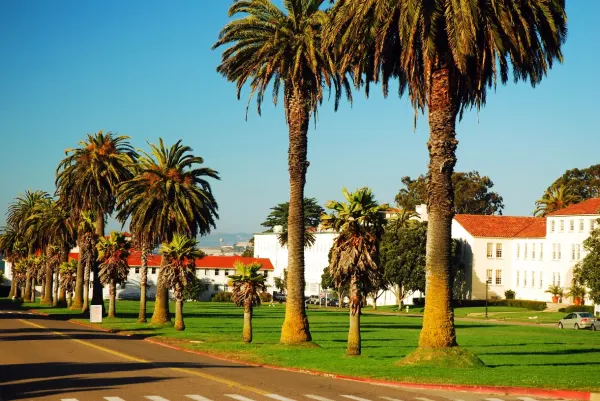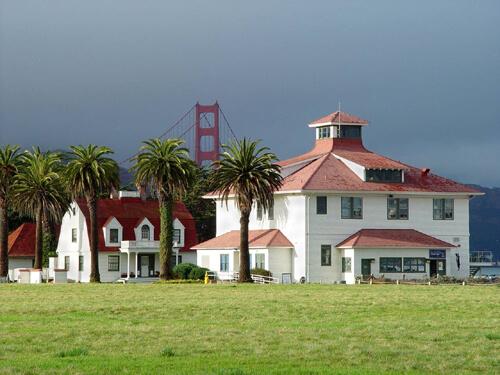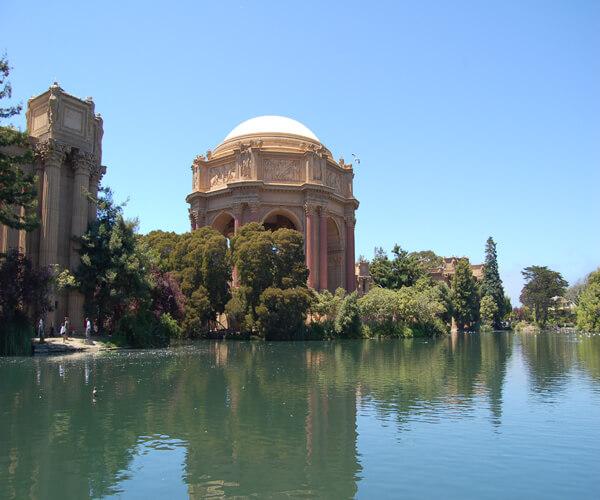Presidio, San Francisco

Beginnings
In 1768 Spanish Emperor Carlos III felt his California colonies in New Spain were being threatened by the English. In 1579 the English privateer Sir Francis Drake had declared Northern California to be Nova Albion or New Britain in the name of Elizabeth I. The British had already colonized Canada, and were at war to retain their colonies on the east coast of North America.
The Emperor may have also been aware of Russian fur traders beginning to search for sea otter pelts on the California coast, perhaps as far south as the San Francisco peninsula. Russian Hill is said to be the location of an early Russian colony and graveyard. Although there is evidence of Russians in the San Fernando Valley of 1776 construction of a Russian trading post at Fort Ross wouldn’t occur for another 37 years.
To protect his California colonies the Emperor sought to expand and reinforce the Spanish presence in California by founding a string of 21 settlements, each a day long ride from the next up the coast of Alta California. This policy would place settlements centered around a Catholic mission where Franciscan missionaries would bring Christianity and agrarian civilization to the indigenous people. The plan was to secularize the missions within a decade of their construction then welcome the native peoples as literate farmers and productive tax paying citizens of Spain. Each settlement was to have a presidio, a military garrison or prison to maintain order, and ensure the neophytes would work and speak only Spanish.
To accomplish this Emperor Carlos III appointed Antonio Maria de Bucareli y Ursua, then Spanish Viceroy or Governor of Cuba, to become the Viceroy of New Spain. Bucareli arrived in Mexico City in 1771 with orders to pursue this settlement policy, expand the Spanish Empire and establish a bulwark against foreign invasion.
Captain Juan Bautista Anza, an officer at the Mexico City Presidio, came to Bucareli in 1772 with a proposal to lead an expedition of settlers to the further reaches of Alta California. Bucareli and the Emperor agreed and on April 19, 1774 the first Anza expedition arrived at Monterey, the Spanish Capital of Alta California. Anza returned to Mexico City the following May. Both Bucareli and Emperor Carlos III were pleased, promoted Anza to lieutenant-colonel, ordered him to return to Monterey and proceed further north in search of a harbor for Spanish galleons and locate sites suitable for additional settlements.
Anza, accompanied by Franciscan Fathers Pedro Font, Francisco Palou, and 12 others, left Mexico for Alta California a second time in October of 1775. By early 1776 he had arrived in Monterey. Then with the priests and a party of twelve soldiers including Lieutenant Jose Joaquin Moraga he continued north.
On March 25, 1776 he camped at arroyo San Jose Cupertino where he found an estuary flowing from the port of San Francisco. Gaspar de Portola was the first to discover an overland route to San Francisco Bay on 10/31/1769 but Anza realized the Bay’s full extent and its potential as a harbor.
Anza and his small company proceeded to the northern tip of the San Francisco peninsula where on March 27, 1776 they pitched camp at a lagoon or spring that today is known as Mountain Lake Park where a plaque marks the point of Anza’s camp.
The next day the group traveled to the edge of the peninsula overlooking the Strait of San Francisco where Anza chose the top of a white cliff he called Punta de Cantil Blanco as the site for El Presidio Real de San Francisco or The Royal Presidio of San Francisco. The lagoon or spring they had camped at the night before would not supply enough water for both a mission and presidio so Anza and his party continued exploring the area.
About two and a half miles to the southeast they came upon a somewhat larger lagoon and creek that Anza named Nuestra Senora de los Dolores since that day happened to be the Friday before Palm Sunday, a feast day honoring the Catholic Virgin Mother “Our Lady of Sorrows”.
The creek, later known as Mission Creek, emptied into the Bay at an inlet where the year before Juan Bautista de Ayala, the first European to sail through the Strait of San Francisco, had come upon three weeping Indians. Ayala named the inlet “Ensenada de los Llorones”, the “Bay of the Weepers”. Also in later years this inlet became Mission Bay. Here Anza chose the site for the Mission San Francisco de Asis. Having completed their mission, Lieutenant Moraga returned to Monterey and Anza to Mexico City.
The First Fort
On June 17 that same year Lieutenant Moraga again left Monterey to return to the site Anza had chosen for the Presidio of San Francisco with 16 soldiers, seven colonists, 200 head of cattle and five Native Americans in charge of pack mules. Moraga and his men built a rude adobe at Punta de Cantil Blanco overlooking the entrance to San Francisco Bay. For years to come the Presidio of San Francisco remained sleepy and probably the most remote outpost of the Spanish empire. By 1783 it was home to a garrison of only 33 men.
By 1792 soldiers at the lonely garrison had built another adobe structure they called the Castillo de San Joaquin to mount the one cannon they had. That year the 330 ton, fully rigged British frigate H.M.S. Discovery sailed into the bay. The Discovery and the HMS Catham had sailed from London on George Vancouver’s 1791-1795 exploration of the Pacific Ocean.
With cause for alarm the Commandante of the Presidio of San Francisco at the time, Alferez Hermenogildo Sal, wrote to the the Spanish Governor in Monterey asking for ten or twelve more guns.
By the next summer the Spanish royal frigate Aranzazu brought six bronze guns cast in Peru more than a century earlier. Later other Spanish vessels had delivered a handful of brass and iron cannon that remained on the beach. The Castillo de San Joaquin fell into disrepair as a spirit of dolce far niente seemed to descend over Alta California.
When Mexico won independence from Spain in 1821 what remained of the Castillo de San Joaquin was abandoned by the Mexican Governor for a new presidio at Sonoma. Two of the cannon are there today, another can be found inside San Francisco’s Fort Point.

The Bear Flag Revolt
Actually the “revolt” was a short lived attempt on the part of a small mob of rowdy, ne’er-do-well, rough-neck Americans and unhappy Californios to create a California Republic independent of Mexico in June 1846.
Californios were original Catalan speaking colonists from Spain whose shared hatred of Mexicans with that mob of misfits was the real driving force behind the “revolt”.
Together the Californios and the rest of the renegade mob “attacked” the Sonoma Presidio in an inconsequential “skirmish”. Actually it was a rowdy wine soaked afternoon at the Sonoma home of Marion Vallejo,
John C Fremont, a topographical engineer and adventurer sent from Washington DC to conduct surveys in the far west joined the band of “revolutionaries”, and rode southwest with ten men including his scout Kit Carson. They stole a longboat to cross the Strait of San Francisco and attack the San Francisco Presidio.
On the crossing Fremont renamed the Strait of San Francisco the “Golden Gate” ostensibly because it bore a similarity to the Golden Horn, a strait in Turkey between the Bosphorus Sea and the Sea of Marmara.
Once ashore they seized the deserted Castillo de San Joaquin and its guns, many of which were lying in the dirt, their wooden carriages rotting away. Fremont claimed he and his men spiked the cannons they found there by driving iron files into the touch-holes.
The Americans
On July 9, 1846, John B. Montgomery, Captain of the sloop U.S. Portsmouth landed a squad of sailors and marines to seize the port of Yerba Buena, the name of the Spanish settlement that had grown a few miles from the Mission de San Francisco Asis and the Presidio of San Francisco on the shore of what today is Chinatown’s Portsmouth Square. It was here Montgomery, in the center of the plaza, raised the Stars and Stripes on a Mexican flagpole and claimed for America a new city he named San Francisco.
The Declaration of Independence had been signed five days before and two days later Commodore John D Sloat raised the American flag in Monterey claiming California a territory of the United States. All this occurred two years before Mexico’s loss in the Mexican American War.
While occupying the Pueblo Yerba Buena, Montgomery sent an armed patrol to seize the Presidio of San Francisco and take what salvageable cannon remained for a new battery he had was building facing the bay near what came to be known as Clark’s Point. Today the area lies along the eponymous Battery Street between Vallejo and Green streets.
That year the US Army took over the Presidio of San Francisco and at first stationed US Cavalry troops there to control Native Americans on the west coast and participate in the “Indian Wars” that ended when Presidio troops joined in the Modoc Indian Campaign or “Lava Bed War” in 1873, the final major US Army battle against Native Americans in the Far West.
Fort Point
In 1853 it was decided that a real fortress was required at the strategic location now known as The Golden Gate. Congress provided half a million dollars to build US installations at the former location of the Castillo de San Joaquin and on Alcatraz Island.
Construction could begin only after the Punta de Cantil Blanco was cut down close to water level. In those days cannon technology still required a smooth bore that only permitted cannon balls fired from shore to remain horizontal with little or no arch to the trajectory. Often when fired over water, cannon balls would skip along the surface before striking a target.
During construction ten 24 pound cannon were mounted in red brick batteries on high ground behind the new fort until construction was complete. Today remains of those batteries can be seen not far from Battery Lancaster around which the south plaza and viewing area of the Golden Gate Bridge was rebuilt in 1987.
The new fort was designed with walls four to seven foot thick and four tiers with granite spiral staircases that led up to mounts for almost 200 cannon. With guard houses, living quarters and a 2,000 foot granite seawall, the most sophisticated fortification on the Pacific coast was built at a cost of almost three million 1860s dollars.
With the advent of the Civil War construction was temporarily stopped but began again when after 1861 Colonel Albert S. Johnston ordered a garrison of 160 artillerymen to occupy and complete what he called the fort at Fort Point. Johnston was born in Kentucky and soon after this order he resigned his commission and joined the Confederacy. Ironically the man who gave Fort Point its name was among the 1,700 Confederate dead after the 1862 Battle of Shiloh.
Interestingly smooth bore cannon and Fort Point itself were rendered obsolete during the civil war with the invention of rifled barrels. To this day no shot has ever been fired from Fort Point. It remains in its original condition at its original location due largely to the foresight of Golden Gate Bridge designer Joseph Strauss who insisted on the steel arch that soars above Fort Point to leave untouched what he believed was a significant architectural achievement.

Time Marches On
From 1890 through 1914 soldiers from the Presidio of San Francisco served as the first park rangers at the new Yosemite and Sequoia National Parks. In 1898 the African-American 10th Cavalry Regiment known as Buffalo soldiers were stationed at the Presidio of San Francisco and were among Theodore Roosevelt’s Rough Riders as he charged up San Juan Hill during the Spanish American War. Soldiers from the Presidio of San Francisco served overseas to put down the Philippine Insurrection from 1898 to 1902.
In 1898 the Army built Letterman Hospital in the Presidio of San Francisco named for Jonathan Letterman an Army surgeon known for bringing modern methods of medical organization to the battlefield. The hospital served the Army throughout the 20th century and was rebuilt in 1969.
In 1903 Buffalo Soldiers from the Presidio of San Francisco served as Theodore Roosevelt’s honor guard during his visit to the post that year.
During the Earthquake and Fire of 1906 soldiers from the Presidio of San Francisco were under the command of the eccentric General Fredrick Funston. Funston’s indiscriminate use of dynamite often did more harm than good in fighting the fire. However he and his troops did manage to build an effective fire-break that stopped the westward spread of the fire by destroying the expansive mansions on double and triple wide city lots that lined the broad Van Ness Avenue of the time. Funston unilaterally declared martial law and his troops did not hesitate to shoot and kill anyone they deemed to be looting in the city.
After the disaster, temporary camps arose at the Presidio of San Francisco where survivors found shelter in tents and earthquake cottages. There they received aid provided by more humane officers and soldiers.
In 1912 20th century artillery began to be placed in batteries along the western portions of the Presidio of San Francisco named as Fort Winfield Scott, a base for the Artillery District of San Francisco.
From 1914 through 1916 Presidio of San Francisco Commander General John J Pershing led the Mexican Punitive Expedition to seek out Mexican rebel leader Pancho Villa who had been leading raids into US territories. In 1915, while Pershing was away, a fire broke out in his Presidio home killing his wife and family.
During World War I from 1917 to 1918 the Presidio of San Francisco hosted temporary housing, recruiting and training facilities. It once again became the point of embarkation for troops and supplies.
Beginning in the 1920s the Army Air Corps took over a section of the San Francisco Presidio that for centuries had been a rich salt marsh and a gathering ground for Native Ohlone peoples. Earlier the area served as the landing site of Spanish explorers, Russian, English and Boston traders. Here the Army Air Corps established an airstrip named Crissy Field.
After World War I it became one of America’s foremost military airfields. The name Crissy Field was chosen in honor of Major Dana H. Crissy, who crashed and died on 8 October 1919 while attempting to land at Salt Lake City, Utah.
Anticipation gripped San Francisco and the nation on February 21, 1921, the day of the experimental first day/night transcontinental flight. At 4:30 am. two planes departed from New York and two from Crissy Field, the two from Crissy Field were piloted by Farr Nutter and Ray Little. Two and one half hours later, after crossing the 14,000 foot Sierra Nevada range, Nutter and Little landed in Reno. Their successful effort, in combination with that of the other westbound pilots, helped launch US Post Office Department’s air mail service.
Crissy Field played a major role in trial night flying. On August 21, 1923, after a four-day demonstration of the transcontinental service, airmail pilot Claire K. Vance completed the west-bound flight, landing at Crissy Field at 6:24 pm.
Crissy field was also the terminus of a “dawn to dusk” transcontinental speed flight on June 23, 1920. Taking off from Mitchell Field, New York, in a modified Curtiss PW-8 fighter, piloted by 1st Lt. Russell Maughan crossed the United States in 21 hours 48 minutes, landing in front of 50,000 people at Crissy Field.
After the bombing at Pearl Harbor in 1941 the Presidio of San Francisco became the headquarters of the Western Defense Command lead by General John L. DeWitt. In the months and years immediately following the attack the west coast was gripped in an almost hysterical paranoia focused on all things Japanese. DeWitt responded by recommending the removal of all ethnic Japanese and their families. President Franklin Roosevelt complied in early 1942.
After the war the Presidio of San Francisco became the home of the Sixth US Army through the Korean and Viet Nam wars.
On Friday, October 11, 1968, 19 year old Private Michael Bunch, imprisoned for having gone AWOL, was shot and killed trying to escape from a work detail at the Presidio of San Francisco stockade where he’d been confined with other servicemen opposed to the Viet Nam War. His death inspired a protest the following Monday known as the “Presidio Mutiny” in which 27 prisoners staged a sit-in at the stockade singing protest songs. Ordered to cease and desist they refused, were forcibly taken away by Military Police and charged with mutiny the next day, an offense punishable by death.
In 1989 the US Congress directed the all branches of the military to deactivate bases throughout the country that were deemed superfluous. In 1994 the Sixth Army was inactivated and the former Letterman Army Hospital was abandoned. In 1995 the Presidio of San Francisco was given over to the National Park Service.
In 1996 the US Congress made the Presidio of San Francisco into the nation’s first urban National Park open to commercial interests. The park is administered by a quasi public organization called The Presidio Trust whose goal is to make the park self sufficient by 2013. Thus any land or building in the park as determined by the Trust is available for rent or any other commercial purpose.
In 2002 most of the former Letterman Army Hospital was demolished to permit Hollywood film director George Lucas to build a campus like setting for his film production company Lucasfilm, his movie special effects firm Industrial Light and Magic and his video game company LucasArts.